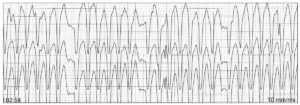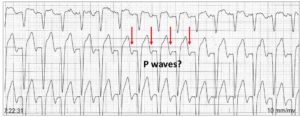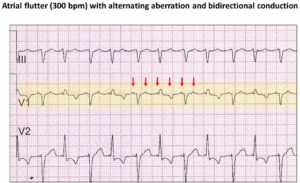I was shown this Holter ECG recording and asked if it was ventricular tachycardia.

The rate is 240 bpm and the rhythm irregular with broad QRS complexes and short pauses or breaks. I wanted more information, so I was shown the next ECG.

The rate has now halved to 120 bpm and the rhythm is regular and the QRS complexes remain broad. There may be P waves present? I wanted more tracings!

Although it doesn’t look like it, the rhythm is regular. The red vertical arrows are P waves and map out at about 240 bpm. There are also runs of alternating narrow complexes (yellow highlight).
The rhythm is supraventricular tachycardia 240 bpm, with 1:1 and 2:1 conduction and alternating aberration. An alternative is atrial flutter, where antiarrhythmic therapy such as flecainide has slowed the atrial rate allowing 1:1 conduction. In this situation, digoxin blocks the AV node and slows the ventricular rate.
If there is 1:1 and 2:1 AV block, then maybe the irregularity seen earlier is Wenckebach AV block?

The first part of the tracing shows the AV block and you can map out the P waves. The irregular broad complex rhythm follows and if we add in the concealed P waves (red stippled vertical arrows), then there is 5:4 Wenckebach AV block with the blue stippled vertical arrows being the dropped beats.
The appearance of atrial flutter or supraventricular tachycardia with block and alternating aberration, frequently gives the appearance of a bidirectional tachycardia of which there are many other causes. The next four tracings are typical examples of bidirectional tachycardia due to atrial tachyarrhythmias.




Dr Harry Mond








